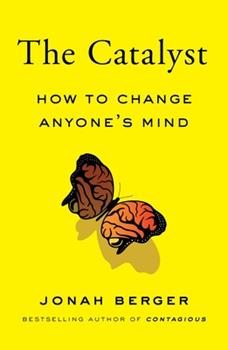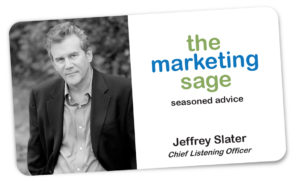When I went to the Jiffy Lube to get my oil changed, I was not going to buy more expensive oil. The clerk said to me, – isn’t coming to get your oil changed a pain and inconvenience? Why not buy the synthetic oil that lasts for 7000 miles instead of the conventional oil for 3,000 miles. It on sale, is cheaper then coming again in 3,000 miles AND you’ll stay out of our shop for a more extended period.
I bought the more expensive synthetic oil.
But I left wondering, how did the clerk so easily convince me to buy the more expensive oil and change my mind.
Catalyst – How To Change Anyone’s Mind – A New Jonah Berger Book

Jonah Berger teaches marketing at Wharton’s Business School at The University of Pennsylvania. His new book Catalyst is a reminder that almost every day, we all try to change someone’s mind.
For marketing professionals, we want to change or persuade a customer’s mind. Disruptive startups want to change industries. In our personal lives, we may want to convince a spouse or family member about a trip to the beach instead of the mountains.
Chair Pushers
Berger uses the analogy of pushing a chair. If you want to change the location of a chair, you push it. And, it moves. You don’t get resistance.
But changing the hearts and minds of people is hard. You can push, but you get resistance. Is there a better way?
The thesis in this book is that you want to be a catalyst. Pushing harder or providing more information isn’t the solution. A catalyst removes hurdles and reduces the barriers to change.
Instead of saying how can I change their mind, they pivot the question to ask, why haven’t they already changed their mind? What is stopping them?
Filled with novel examples, Berger’s book Catalyst tells the story of how hostage negotiators get people to come out with their hands up. Or how marketing professionals find ways to get a new product to be adopted. There are examples of how leaders shift and transform cultures or activists to inspire and ignite social movements.
In the book, you’ll learn about Greg, the FBI agent turned hostage negotiator after he witnessed a hardened international criminal turn himself in without a fight.
And, you’ll meet Chuck, who was able to decrease teen smoking rates by 75% by using the power of reactivity. Instead of smoking, he asked teens to consider rebelling against the cigarette companies who are the ones influencing your behavior.
If The Shoe Fits
In 1999, a company called www.shoesite.com was one of the first sites to sell shoes online. In the late ’90s, when they opened their doors i.e., website, no one wanted to buy their shoes even though they carried lots of brands and sizes.
You may know this company by its current name – Zappos. The founder realized that consumers were fearful of buying online, and they didn’t want to pay for shipping.
Remember what the early Internet days were like?
When they started to offer free shipping, they removed a hurdle. It shifted the resistance, and free shipping became Zappo’s catalyst to success.
Test Drive
Think of going to the car a dealer and paying $40K for a new car but never taking it out for a test drive. When you test drive a vehicle, a barrier gets removed. You see what it feels like to be in the driver’s seat. How does it make you feel and, does the car meet your functional requirements? Long ago, car dealers realized that test drives would eliminate a barrier to purchase. Today, freemium models for technology and software providers that same sampling opportunity.
Political Canvassing
Another story in the book is how canvassers use tactical empathy to change the mind of voters. Berger urges not to think of being in someone’s shoes to experience what they feel. Instead, he suggests harnessing a similar feeling or experience from your life – how did you think and react. By using this tactical empathy approach, you gain a more visceral understanding of what is holding someone back from changing their mind.
R.E.D.U.C.E.
Berger uses the acronym REDUCE to help you when you are trying to reduce the resistance toward persuading someone.
- Reactance: When pushed, people push back. Stop throwing facts at them and start asking questions that begin with why, how, and what. (THINK: ENGAGEMENT)
- Endowment: People don’t like change. People won’t change even if the difference is to their benefit. Try focusing on the costs of not changing. (THINK: EMOTIONAL BENEFITS)
- Distance: When someone has an opposite opinion of yours or when you have a massive ask, consider asking for less. (THINK: INCREMENTAL MOVEMENT)
- Uncertainty: People are risk-averse. Look for ways to remove or eliminate risk. Make things easy to try. (THINK: FREE SHIPPING/FREMIUM TRIAL)
- Corroborating Evidence: This is related to risk. Some people need more corroborating evidence from multiple sources. (THINK: TESTIMONIALS)
Another fabulous book on persuassion is the classic by Robert Cialdini and his new book Presuasion. If you are a marketer, you’ll want to read Jonah Berger’s books along with the Cialdini series.
Have I changed your mind to go buy Jonah’s book?
Need help changing customer’s minds?
I can help. You can set up a time chat with me about your marketing challenges using my calendar. Our initial conversation is free. You talk, I listen. Email me jeffslater@themarketingsage.com or call me. 919 720 0995. Visit my website at www.themarketingsage.com. Let’s explore working together today.

Photo by Pierre Bamin on Unsplash




